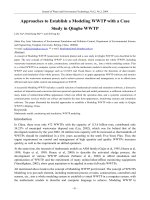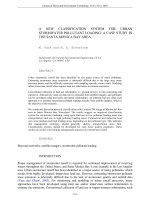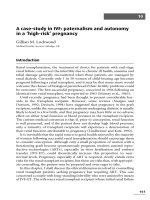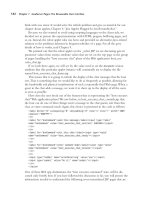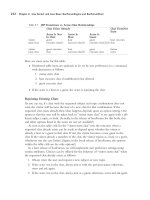The Electric Sheep Screen-Saver: A Case Study in Aesthetic Evolution ppt
Bạn đang xem bản rút gọn của tài liệu. Xem và tải ngay bản đầy đủ của tài liệu tại đây (2.54 MB, 10 trang )
The Electric Sheep Screen-Saver: A Case Study in
Aesthetic Evolution
Scott Draves
Spotworks, San Francisco CA, USA
Abstract. Electric Sheep is a distributed screen-saver that harnesses idle com-
puters into a render farm with the purpose of animating and evolving artificial
life-forms known as sheep. The votes of the users form the basis for the fitness
function for a genetic algorithm on a space of fractal animations. Users also may
design sheep by hand for inclusion in the gene pool. This paper describes the
system and its algorithms, and reports statistics from 11 weeks of operation. The
data indicate that Electric Sheep functions more as an amplifier of its human col-
laborators’ creativity rather than as a traditional genetic algorithm that optimizes
a fitness function.
1 Introduction
Electric Sheep [5] [6] was inspired by SETI@Home [1] and has a similar design. Both
are distributed systems with client/server architecture where the client is a screen-saver
installable on an ordinary PC. Electric Sheep distributes the rendering of fractal anima-
tions. Each animation is 128 frames long and is known as a sheep.
Besides rendering frames, the client also downloads completed sheep and displays
them to the user. The user may vote for the currently displayed sheep by pressing the
up arrow key.
Each sheep is specified by a genetic code comprised of about 160 floating-point
numbers. The codes are generated by the server according to a genetic algorithm where
the fitness is determined by the collective votes of the users. This is a form of aesthetic
evolution, a concept first realized by Karl Sims [9] and analyzed by Alan Dorin [3].
This is how Electric Sheep worked until March 2004, when a new source of genomes
appeared: Apophysis [10]. Apophysis is a traditional, stand-alone Windows GUI to the
sheep genetic code primarily intended for still-image design, but useful for key-frame
animation. Besides a traditional direct manipulation interface where the user drags slid-
ers and types numbers into labeled fields, it includes a Sims-style mutation explorer.
In March, Townsend and Draves connected this application to the Electric Sheep
server. A simple menu command causes the current genome to be posted to the server,
rendered, and distributed to all active clients. If the resulting animation receives votes it
may reproduce and interbreed with the artificially evolved population.
Not surprisingly, these posted genomes proved much more popular than the purely
random ones. And as they are subject to mutation and crossover, the genetic algorithm
creates variants of them. One can compare the total amount of quality animation to the
amount that was human designed. This ratio is the creative amplification factor of the
system, as discussed in Section 6.1.
The rest of this paper is structured as follows: Section 2 describes the architecture
and implementation of Electric Sheep. Section 3 briefly explains the concept and artistic
goals of the project. Section 4 surveys the genetic code on which all sheep rendering
and evolution is based, and Section 5 explains the genetic operators and the specifics of
the evolutionary algorithm. Section 6 reports empirical results of running this system
for over 11 weeks during which time more than 6000 sheep were born. Section 7 puts
this work in context of past research, and Section 8 concludes.
Fig.1. Sheep 15875, on the top-left, was born on August 16 and died 24 hours later after receiving
one vote. It was one of 42 siblings. It was reincarnated on October 28 as sheep 29140, received
a peak rating of 29, lived 7 days, and had 26 children, 8 of which appear to its right. Below are
five generations of sheep in order starting on the left. Their numbers are 1751, 1903, 2313, 2772,
and 2975. The last is a result of mutation, the previous three of crossover, the first was posted by
etomchek.
2 Architecture and Implementation
Electric Sheep has a client/server architecture. The client initiates all communication
between them, and if no client were running the server would not run at all.
The client has three main threads. One thread downloads sheep animations from the
server to a local disk cache. It downloads those with highest rating first. The default
size of the cache is 300Mbytes (enough for 65 animations) but the user may change it.
Another thread reads the sheep from the cache and displays them in a continuous se-
quence on the screen. The third thread contacts the server, receives a genome specifying
a frame to render, renders the frame, then uploads the resulting JPEG file.
The server maintains several collections of sheep. Sheep are numbered as they are
created and are identified by this sequence number. Freshly conceived genomes start
out in the render queue. When all the frames of a sheep have been uploaded, they are
compressed into MPEG and deleted, and the sheep is made available for download and
voting. Sheep average 4.6Mbytes each. Eventually the sheep dies (Section 5.2 explains
when) and the MPEG file is deleted.
All these sheep are referred to collectively as a generation. Each time the server
is reset the database is wiped, all sheep are deleted from the server and from all client
caches, the generation number is incremented, and evolution starts fresh. The sheep that
are the subject of this paper are members of generation 165.
The server is implemented with two machines in separate colocation facilities. Both
are commodity Linux x86 servers running Apache. One runs the evolutionary algo-
rithm, collects frames and votes, compresses frames, and sends genomes to clients
for rendering. The other only serves the completed MPEGs. The first server receives
221Kbit/s from the clients and transmits 263Kbit/s to them (measured average of July
to October 2004). The MPEG server’s bandwidth allocation has varied from 15 to
20Mbit/s, and it uses all of it.
The MPEG server is currently the bottleneck in the system. A future version of
Electric Sheep will use a P2P network to distribute this bandwidth load much as the
computation load already is.
The client runs on Linux, OSX, and Windows. It uses only the HTTP protocol
on port 80 and it supports proxies. However, it does require a broadband, always-on
connection to the internet. When the server is not reachable the client’s sheep display
still works but no new sheep appear.
All the code is open source and is licensed under the GPL (General Public License).
The fractal flame utilities are written in C and the server is written in Perl. The clients
are written in C, C++, and Objective-C.
3 Concept and Motivation
Electric Sheep is an attention vortex. It illustrates the process by which the longer and
closer one studies something, the more detail and structure appears. Electric sheep in-
vestigates the role of experiencers in creating the experience. If nobody ran the client,
there would be nothing to see. The sheep system exhibits increasing returns on each of
its levels:
– As more clients join, more computational muscle becomes available, and the reso-
lution of the graphics may be increased, either by making the sheep longer, larger,
or sharper. The more people who participate, the better the graphics look. These
adjustments are made manually on the server or with new client releases.
– Likewise, as developers focus more of their attention on the source code, the client
and server themselves become more efficient, grow new features, and are ported
into new habitats. The project gains momentum, and attracts more developers.
– And as more users vote for their favorite sheep, the evolutionary algorithm more
quickly distills randomness into eye candy.
The votes tell the server which sheep are receiving the most attention. Those sheep
are elaborated, expanding the variety and detail of those parts of the fractal space that
are most interesting.
There is a deeper motivation however: I believe the free flow of code is an increas-
ingly important social and artistic force. The proliferation of powerful computers with
high-bandwidth network connections forms the substrate of an expanding universe. The
electric sheep and we their shepherds are colonizing this new frontier.
4 The Genetic Code
Each image produced by Electric Sheep is a fractal flame [4], a generalization and
refinement of the Iterated Function System (IFS) category of fractals [2]. The genetic
code used by Electric Sheep is just the parameter set for these fractals. It consists of
about 160 floating-point numbers.
A classic IFS consists of a recursive set-equation on the plane:
S =
n−1
i=0
F
i
(S)
The solution S is a subset of the plane (and hence a two-tone image). The F
i
are a small
collection of n affine transforms of the plane.
A fractal flame is based on the same recursive equation, but the transforms may
be non-linear and the solution algorithm produces a full-color image. The transforms
are linear blends of a set of 18 basis functions known as variations. The variations are
composed with an affine matrix, like in classic IFS. So each transform F
i
is:
F
i
(x,y) =
∑
j
v
ij
V
j
(a
i
x+ b
i
y+ c
i
,d
i
x+ e
i
y+ f
i
)
where v
ij
are the 18 blending coefficients for F
i
, and a
i
through f
i
are 6 affine matrix
coefficients. The V
j
are the variations, here is a partial list:
V
0
(x,y) = (x, y) V
3
(x,y) = (rcos(
θ
+ r),rsin(
θ
+ r))
V
1
(x,y) = (sinx,siny) V
4
(x,y) = (rcos(2
θ
),rsin(2
θ
))
V
2
(x,y) = (x/r
2
,y/r
2
) V
5
(x,y) = (
θ
/
π
,r− 1)
where r and
θ
are the polar coordinates for the point (x,y) in rectangular coordinates.
V
0
is the identity function so this space of non-linear functions is a superset of the space
of linear functions. See [4] for the complete list.
There are 3 additional parameters for density, color, and symmetry, not covered
here. Together these 27 (18 for v
ij
plus 6 for a
i
to f
i
plus 3 is 27 total) parameters
make up one transform, and are roughly equivalent to a gene in biological genetics. The
order of the transforms in the genome does not effect the solution image. Many trans-
forms have visually identifiable effects on the solution, for example particular shapes,
structures, angles, or locations.
Normally there are up to 6 transforms in the function system, making for 162
(6 × 27) floating-point numbers in the genome. Note however that most sheep have
most variational coeffients set to zero, which reduces the effective dimensionality of the
space.
4.1 Animation and Transitions
The previous section described how a single image rather than an animation is defined
by the genome. To create animations, Electric Sheep rotates over time the 2× 2 matrix
part (a
i
, b
i
, d
i
, and e
i
) of each of the transforms. After a full circle, the solution image
returns to the first frame, so sheep animations loop smoothly. Sheep are 128 frames
long, and by default are played back at 23 frames per second making them 5.5 seconds
long.
The client does not just cut from one looping animation to another. It displays a
continuously morphing sequence. To do this the system renders transitions between
sheep in addition to the sheep themselves. The transitions are genetic crossfades based
on pair-wise linear interpolation, but using a spline to maintain C
1
continuity with the
endpoints.
Transitions are also 128 frames long. For each sheep created, three transitions are
also created: one from another random flock member to the new sheep, one from the
new sheep to a random flock member, and another one between two other random mem-
bers. Most of the rendering effort is spent on transitions.
5 The Genetic Algorithm
There are three parts of the genetic algorithm: the rating system that collects the votes
and computes the fitness of individual sheep, the genetic operators used to create new
genomes, and the main loop that controls which live and die.
As already mentioned, users can vote for a sheep they like by pressing the up arrow
key. If the sheep is alive its rating is incremented. Pressing the down arrow key decre-
ments the rating. Votes for dead sheep are discarded. Users may also vote for or against
a sheep by pressing buttons on its web page.
The ratings decay over time. Each day the ratings are divided by four with integer
arithmetic rounding down.
5.1 Genetic Operators
There are four sources of genomes for new sheep: random, mutation, crossover and
posts from Apophysis. The parents for mutation and crossover operators are randomly
picked from the current population weighted by rating. The probability of being selected
is proportional to the rating. Sheep that have received no votes have rating zero and so
cannot be selected.
random The affine matrix coefficients are chosen with uniform distribution from
[-1, 1]. The variational coefficients are set to zero except for one variation chosen at
random that is set to one.
crossover The crossover operation has two methods chosen equally often. One
method creates a genome by alternating transforms (genes) from the parents. The other
method does pair-wise linear interpolation between the two parent genomes where the
blend factor is chosen uniformly from [0, 1].
mutation The mutation operator has several different methods: randomizing just
the variational coefficients, randomizing just the matrix coefficients of one transform,
adding noise (-10 decibels, or numbers from [-0.1, 0.1]) to all the matrix coefficients,
changing just the colors, and adding symmetry.
When applying these three automatic operators, the server renders a low-resolution
frame and tests if the image is too dark or too bright. The operator is iterated until the
resulting genome passes. For random genomes, 43% are rejected (in a test run 177 tries
were required to get 100 passing genomes).
post Human designers may post genomes to the server with Apophysis. The de-
signer is required to submit a password with the genome, but its value is shared on a
public email list and is common knowledge there. The genome is checked for syntactic
correctness, but the image it creates is not tested.
The server has a queue of sheep and transitions that are currently being rendered.
Posted genomes go into this queue. When the queue is left with fewer than 12 sheep,
it is filled with genomes derived with one of the three automatic operators. 1/4 of these
genomes are random and have no ancestor. The remaining 3/4 are divided equally be-
tween mutation and crossover.
5.2 The Main Loop
The server maintains a single flock of sheep and continuously updates their ratings,
creates new sheep, and kills off old ones. The server has 510MB of disk space for
storing sheep animations, enough for 28 sheep and 83 transitions. Each time a sheep is
born, the sheep with the lowest rating is killed to make room. If several sheep are tied
for worst, then the oldest is taken (usually several sheep have received no votes and are
tied with a rating of zero).
Killing a sheep removes the animation file from the server, but not from clients who
may have allocated more disk space to their caches. The other records, including the
peak rating, parentage, genome, 16 thumbnails, and the first frame are kept. This archive
may be browsed on the server either sorted by peak rating, or as extended family trees.
This on-line or steady-state approach contrasts with the more traditional genetic al-
gorithm’s off-line main loop that divides the population into generations and alternates
between rating all the individuals in a generation and then deriving the next genera-
tion from the ratings. Note that Electric Sheep does have ‘generations’, but it means
something else, see Section 2.
6 Empirical Results
Three main datasets are analyzed below. The voting and posting data are from the web
server log files from August 7th to November 4th 2004, 90 days later. Another dataset
has daily aggregate usage reports from the server June 18th to October 31st (139 days).
The primary dataset was collected from the server’s database starting May 13th
until October 13th, 153 days later. May 13th is when version 2.5 became operational.
Previous versions of the server did not keep a record of the sheep: when they died
they were completely deleted from the server. And though there are large collections of
sheep collected by clients from before May 13th, they are not complete and they lack
fields for ratings and parentage.
During this time the server was subject to performance optimization but the basic
algorithm remained fixed with one exception: until July 13th there was no limit on how
many votes a user could make. An increasing incidence of users voting many times in
rapid succession instigated a limit of 10 votes per user per day. The numbers below are
from after that change.
The data we have collected are a starting point to understanding the system and its
behavior. However, they are somewhat confounded:
– IP addresses are equated with users, but because of the prevalence of Network Ad-
dress Translation (NAT), several or many users may appear as the same IP address.
Worse, some computers are assigned an IP address dynamically, so one user may
appear under many addresses.
– The client uses the ratings to prioritize downloading. Now that the server is busy
enough that some clients cannot download all the sheep, this causes a snowball
effect where a high rating itself causes more votes.
– The audience is fickle: sheep with identical genomes regularly receive completely
different ratings (See Figure 1). Presumably the audience becomes fatigued by re-
peated exposure to variations of a successful genome, and stops voting for them.
Even once popular sheep reintroduced much later do not necessarily fare well.
– Designers may vote for their own sheep, post many similar sheep, or post alterations
of the results of automatic evolution. The administrator occasionally kills sheep,
explicitly directs mating, mutation, reincarnation, and votes without limit.
There are many ways of measuring the number of users. Figure 2 shows four of
them, and a graph of the rate of new users trying the system. The daily downloaders
linear growth rate is 9 users per day, far fewer than the hundreds of new addresses per
day. When Electric Sheep is first installed and run it takes quite some time (often about
ten minutes but according to some reports hours or even days) to download and display
the first sheep. Perhaps many people decide the software is broken and remove it. Or it
could result from miscounting dynamic IP addresses.
There were on average 166 downloads of the client installers per day from the home-
page during the first 8 days of December. But the installers are distributed on CD-ROM
and mirrored on high-volume sites such as nonags.com, debian.org, and freebsd.org
from which no statistics are available. These secondary sites also lack preview graphics
and explanation so users from them may be likely to remove it.
Figure 3 shows the distribution of how many clients had a given number of days
of activity (at least one attempted download). 1839 clients were active half the days or
more, and 65 were active every day. Using data collected from November 2 to Novem-
ber 7 2004, there were 626 votes made, 76% with the arrow keys on client, and 24%
with the web site.
The average number of valid votes per day is 111. During the 90 day period votes
were received from a total of 1682 different client IP addresses. The average number of
posts per day is 10.8 from a total of 64 different client IP addresses.
0
1000
2000
3000
4000
5000
6000
7000
8000
07/11 08/11 09/11 10/12
hourly uploaders
daily uploaders
weekly uploaders
daily downloaders
500
550
600
650
700
750
800
09/10 10/11
Fig.2. On the left is a graph of number of users over time. Downloaders refers to clients down-
loading sheep, uploaders refers to clients uploading rendered frames. The dip from 9/2 to 9/19
coincides with server outages. On the right is a graph of the number of new client addresses over
time. The total number of unique downloaders is 62000.
1
10
100
1000
10000
0 2 4 6 8 10 12 14
10
100
1000
1 2 4 8 16 32
1
10
100
1000
1 2 4 8 16 32 64 128 256 512
10
100
1000
10000
100000
1 2 4 8 16 32 64 128
Fig.3. On the top-left is a histogram of lengths of lineages, and on the top-right is a histogram of
the ratings of the sheep. On bottom-left is a histogram of the sum of ratings of all descendents.
Children of two parents contribute half of their sum to each parent. On the bottom-right is a
histogram of number of days of activity out of 90 total possible by each IP address. 1839 clients
were active half the days or more, and 65 were active every day (the upturn on the far right).
6.1 Amplification of Creativity
In a system with human-computer collaboration, the creative amplification is the ra-
tio of total content divided by the human-created content. If we compare the posted
genomes with their evolved descendents we can measure how much creative amplifica-
tion Electric Sheep provides.
In the primary dataset there were 21% hand-designed, posted sheep and 79% evolved
sheep. If the sum is weighted by rating, then we get 48% to 52%, for an amplification
factor of 2.08 (1+52/48). One could say the genetic algorithm is doubling the output of
the human posters.
Of the 79% evolved sheep, 42% of them result from the totally random genetic
operator. Their fraction of total ratings is only 3.8%.
There are some caveats to this metric. For example, if the genetic algorithm just
copied the posted genomes, it might receive some votes for its ‘creativity’. Or if it
ignored the posted genomes and evolved on its own, it would receive some votes but
they would not represent ‘amplification’.
Figure 3 shows the distribution of lengths of lineages of the sheep. The lineage
length of a sheep is the maximum number of generations of children that issue from
it. Sheep with no children are assigned one, and sheep with children are assigned one
plus the maximum of the lineage lengths of those children. Instead of fitness increasing
along lineage, we find it dying out: the rating of the average parent is 6.7 but the average
maximum rating of direct siblings is only 3.8.
The decay in ratings may result from the audience losing interest in a lineage be-
cause it fails to change fast enough, rather than a decay of absolute quality of those
sheep. The viewpoint of watching the screensaver and seeing sheep sequentially is dif-
ferent from the viewpoint of browsing the archive and comparing all the sheep. Neither
can be called definitive.
Genetic algorithms normally run for many tens to hundreds or thousands of gener-
ations. In contrast, the lineages (number of generations) of the sheep are very short: the
longest is 13.
7 Related Research
There are now many distributed screen-savers. Most are scientific (SETI@Home, cli-
mateprediction.net), cryptographic (distributed.net) or mathematical (zetagrid.net), rather
than graphical or artistic. The Golem@Home project [7] has a evolutionary algorithm
for evolving locomotion in electro-mechanical assemblages.
The aesthetic selection used by Electric Sheep is inspired by Karl Sims [9]. His
supercomputer is replaced by internet-connected commodity PCs. The sheep voting
community is much larger but much less focused than his user-base. Sims used Lisp
expressions on pixel coordinates, but also included a primitive for IFS.
The International Genetic Art IV project [8] uses a web-based Java client to evolve
images following the technique of Sims. Since the images are rendered on the clients,
the computation is distributed, but users do not share votes or the gene pool. Its previous
incarnation, International Genetic Art II, ran on a single server with a web interface so
the computation was not distributed but the voting and gene pool were shared by all
users.
8 Summary and Conclusion
Electric Sheep is a distributed screen-saver for animating and evolving fractal flames,
a kind of iterated function system. The animations are shared among the clients and
displayed in parallel with rendering. The evolution is guided by the will of the audience.
The genetic code is made of geometric transforms, each one containing 6 coefficients
for an affine transform of the plane and 18 coefficients for blending the variational
functions.
The genetic algorithm employed does not converge on an optimal solution, but fol-
lows the attention of the users. And while the genetic algorithm is not competitive with
the human designs, it does serve to effectively elaborate and amplify human designs.
Acknowledgements
Many thanks to: The anonymous reviewers, Tamara Munzner, and Matthew Stone for
providing feedback on drafts of this paper, Dean Gaudet for help with performance
optimization and server hosting, Tristan Horn for hosting the high-bandwidth server,
Matt Reda and Nick Long for porting the client to OSX and Windows, respectively.
And to all those who sent in patches, reported bugs, voted for their favorite sheep, or
just ran the software once.
References
1. David Anderson et al: SETI@home: An Experiment in Public-Resource Computing. Com-
munications of the ACM 45 (2002) 56–61.
2. Michael Barnsley: Fractals Everywhere. Academic Press, San Diego, 1988.
3. Alan Dorin: Aesthetic Fitness and Artificial Evolution for the Selection of Imagery from
The Mythical Infinite Library. Advances in Artificial Life, Proc. 6th European Conference
on Artificial Life, (2001) 659–668.
4. Scott Draves: The Fractal Flame Algorithm. Forthcoming, available from
/>5. Scott Draves: The Interpretation of Dreams. YLEM Journal 23;6 (2003) 10–14.
6. Scott Draves: The Electric Sheep web site at .
7. Hod Lipson and Jordan B. Pollack: Automatic Design and Manufacture of Robotic Life-
forms, Nature 406 (6799), 2000 August 31, 945–947.
8. John Mount, Scott Reilly, Michael Witbrock: International Genetic Art IV. Published on the
web at />9. Karl Sims: Artificial Evolution for Computer Graphics. Proceedings of SIGGRAPH 1991,
ACM Press, New York.
10. Mark Townsend: Apophysis v2 software distributed from . 2004.

